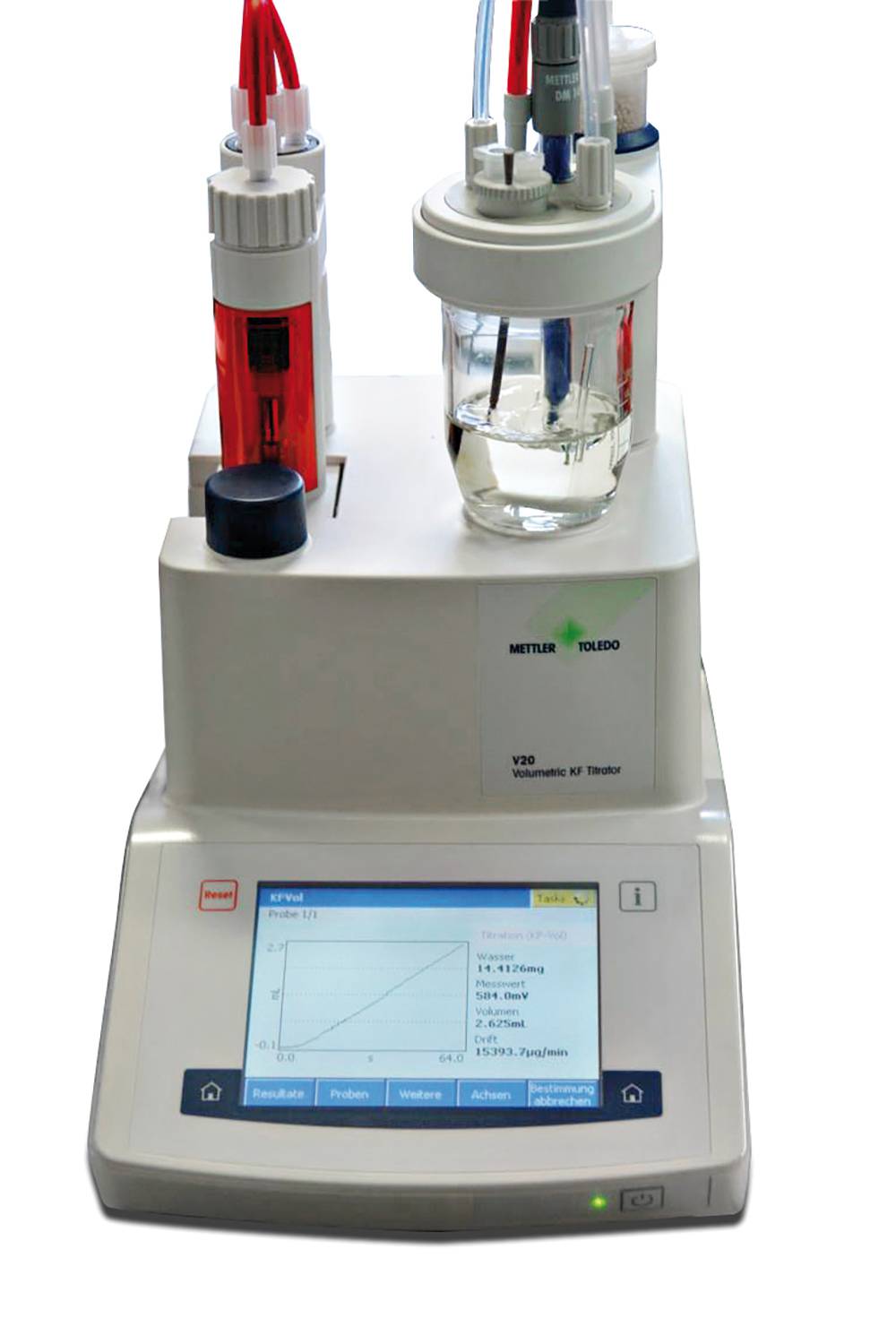Water analysis - Fast and precise
OELCHECK investigates every oil and grease sample for its water content with analysis kits. Ultimately, water generally poses a high risk to all lubricated components. In high concentrations in waste oil, it can affect lubricant film formation and cause the corrosion of machine parts.
However, there are liquids, which as fresh oil, already have a high water content or only function with a high water content. A typical example are fire-resistant hydraulic oils. Of these fluids, about 50% of the water content must also be checked. In such a high range however, the usual method of coulometric water analysis based on the Karl Fischer principle (ÖlChecker Winter 2000) can no longer be used. This method can only be used to reliably determine water contents within a trace range of less than 10 ppm up to about 10,000 mg/kg, i.e. up to 1%. A further titrator has now been installed to allow the OELCHECK laboratory to perform fast and accurate water analyses for water concentrations of more than 1%. It is used to determine the water content using the volumetric method for lubricants with higher water contents.
Coulometric determination of the water content
Water analysis based on coulometric methods is ideal for lubricants with a water content in a trace range of 10 ppm up to several thousand ppm (mg/kg). In this way, water contained in the sample is quasi „boiled out“. For determination using water vapour, additives and other sample components which could disturb titration, as when using a direct method, are retained in the sample.
Titration is a procedure used in quantitative analysis in chemistry. A known substance with an unknown concentration is converted in a chemical reaction using a standard solution with a precise concentration. The volume of the spent standard solution is measured and the unknown concentration of the sample solution calculated. Quantitative water analysis by titration was named after the German chemist Karl Fischer, who developed the method.
A method is described as coulometric if it is used to determine the quantitative amount of an oxidable or reducible compound. It is based on measurement of the electrical charge or amount of electricity converted at a working electrode. In the indirect coulometric determination of the water content, about 2 g of the lubricant sample is weighed into a glass vessel and hermetically sealed with a septum. The sample is subsequently heated to 140°C in an oven integrated in an autosampler. At the same time, the septum is pierced with a hollow needle and the sample vessel flushed with nitrogen. The vaporised water is transferred in this nitrogen stream into the actual measuring cell where it is initially titrated. This method is therefore classified as an indirect titration procedure.
A measuring cell contains a special Karl Fischer reagent from which iodine is produced by means of a generator electrode. As long as the nitrogen stream flushes water vapour from the sample glass into the measuring cell, it immediately reacts there with the iodine. The generator electrode must permanently compensate this loss of iodine and uses electrical current in the process. Once the water from the sample has reacted, the produced iodine remains unused in the measuring cell.
This condition is detected by a second electrode, the indicator electrode, and titration is ended. The water content of the sample can be calculated based on the amount of electricity used.
The coulometric method is extremely sensitive. The supply of electricity to the generator electrode is precisely regulated so that iodine is only produced in very small quantities. This enables precise determination of the water content from 10 mg/kg.
Volumetric analysis of water content
In some applications however, special lubricants with water contents of several per cent are required. A typical example of this are fire-resistant HFC fluids (see page 5-7). These fluids normally have water contents between 20 and 50%. However, glycol-based synthetic oils, such as those used in worm gears, usually contain over 2,000 ppm water as fresh oil. For such samples, the limits of coulometric water analysis are reached. On account of the finely dosed production of iodine in the titration cell, each individual determination would take a long time in order to produce iodine corresponding to the high water volume.
Since March of this year, OELCHECK has been using the new, direct volumetric Karl Fischer titrator for determining the water content of such lubricants. In this process, water is not removed by heating, instead the sample is injected directly into the measuring cell. The required iodine is present in a solution which is continuously added in small amounts with a burette. The rest of the process is identical with the coulometric method: when the water has reacted, unused iodine remains in the solution and is detected by the indicator electrode. Titration is complete. The water content is calculated from the used volume of titration solution rather than from the amount of electricity used.
With three Karl Fischer titrators, the OELCHECK laboratory is now optimally equipped for rapid and precise water analyses in all concentration ranges, with the coulometric procedure for trace levels of up to several thousand mg/kg and with the volumetric procedure for lubricants with higher water contents of up to 100%.
ÖlChecker Winter 2011, page 3




